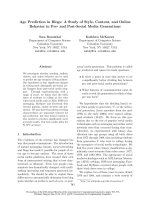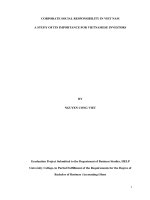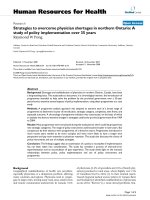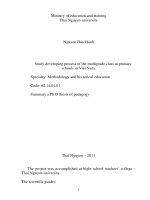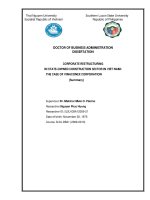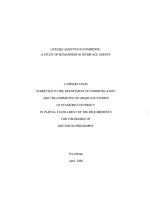corporate social responsibility in viet nam a study of stakeholders’ perceptions of corporate social responsibility
Bạn đang xem bản rút gọn của tài liệu. Xem và tải ngay bản đầy đủ của tài liệu tại đây (449.58 KB, 74 trang )
i
CORPORATE SOCIAL RESPONSIBILITY IN VIET NAM: A STUDY OF
STAKEHOLDERS’ PERCEPTIONS OF CORPORATE SOCIAL
RESPONSIBILITY.
BY
PHAM VAN THUAN
Graduation Project Submitted to the Department of Business Studies, HELP
University College, in Partial Fulfillment of the Requirements for the Degree of
Bachelor of Business (Accounting) Hons
October 2010
ii
Declaration of Originality and Word Count
DECLARATION
I declare that this graduation project is based on my original work except for quotations
and citation which have been duly acknowledged. I also declare that it has not been
previously or concurrently submitted for any other courses/degrees at HELP University
College or other institutions.
Word Count: 11,523 Words.
Pham Van Thuan
Date
iii
Abstract
CORPORATE SOCIAL RESPONSIBILITY IN VIET NAM: A STUDY OF
STAKEHOLDERS’ PERCEPTIONS OF CORPORATE SOCIAL
RESPONSIBILITY.
BY
PHAM VAN THUAN
October 2010
Supervisor: Dr. Nguyen Thi Phuong Hoa
Corporate Social Responsibility has developed through the long history and it is also
expected to implement by any business entities in the world. It is no longer a new term
for developing countries such as Viet Nam. However, in recent year, when the economic
is open and there are a lot of scandals and critical case concerning about the Corporate
Social Responsibility and ethical business as the result of the economic boom. So, there
are a lot of researches on that field; however the understanding of Corporate Social
Responsibility is limited in Viet Nam. Therefore, it may be as a result of motivation for
the researcher to conduct the survey about the perceptions of CSR among Vietnamese
individual investors in TL Securities Company’s office (TLS).
In this study, the researcher wants to access the understanding of Vietnamese individual
investors on the topics of CSR. Further more, the researcher will to define the three
factors which contribute to the CSR perceptions such as CSR awareness, investment
decision and CSR reporting base on the understanding and opinion of the investors.
iv
By conducting the research, the research is able to indicate that the understanding of
CSR concepts and its perceptions is limited; because of the investors have little basic
knowledge about the CSR. So, the investors in Viet Nam are very hard to use CSR
information as a tool to value firm and it is also difficult for them to make investment
decision.
v
Table of contents
Declaration of Originality and Word Count ii
DECLARATION ii
Abstract iii
Table of contents v
List of Figures and Tables ix
List of Figures and Tables ix
List of Abbreviations x
CHAPTER 1: INTRODUCTION xi
1.2 Research Background 1
1.1.1 CSR in the world 1
1.1.2 CSR in Vietnam 1
1.3 Problem Statement 3
1.3 Objectives and Sphere of Research 4
1.3.1 Objectives of Research 4
1.3.2 Sphere of Research 5
1.4 Research Methods 5
1.5 Structure of Research 6
CHAPTER 2: LITRERATURE OF REVIEW 7
2.1.4 Investment Decision 7
2.2.1 Business Ethics in Viet Nam – Reality and Solutions 7
2.2.2 CSR in business entities in Viet Nam – Reality and Solutions 7
2.2.3 CSR – The Investors’ Perspective 7
2.2.4 CSR, PR of Foreign-Invested Companies 7
vi
2.3 Researches Summary 7
2.1 Research’s related concepts 8
2.1.1 Carroll's 1979-1991 conceptualization 9
2.1.2 Wood 1991 conceptualization 11
2.1.3 Stakeholder theory 13
2.1.4 Investment Decision 14
2.1.5 Responsible Investment 15
2.1.6 Investor Relation 15
2.1.7 CSR Reporting 16
2.1.8 CSR practice and challenges 19
2.2 Researches and Studies 20
2.2.1 Business Ethics in Viet Nam – Reality and Solutions 20
2.2.2 CSR in business entities in Viet Nam – Reality and Solutions 21
2.2.3 CSR – The Investors’ Perspective 22
2.2.4 CSR, PR of Foreign-Invested Companies 23
2.3 Researches Summary 24
Table 1: Researches and Studies Summary 26
CHAPTER 3: RESEARCH METHODOLOGY 27
3.1 Research Objectives 28
3.2 Theoretical Framework and Measurement 28
3.2.1 CSR perceptions 29
3.2.2 CSR Awareness 29
3.2.3 Investment Decision 30
3.2.4 CSR Reporting 30
3.3 Measurement and Quality Design 30
vii
3.3.1 Section 1 31
3.3.2 Section 2 31
3.3.2.1 CSR Awareness 32
3.3.2.2 Investment Decision 33
3.3.2.3 CSR Reporting 33
3.4 Research Method 34
3.4.1 Sampling 35
3.5 Hypothesis Statement 35
3.5.1 Correlation of Independent Variable 36
CHAPTER 4: RESULT ANALYSIS 37
4.1 Collection of Questionnaires 38
4.2 Description of Result 38
4.2.1 Age 38
Table 2: Age 38
4.2.2 Gender 39
Table 3: Gender 39
4.2.3 CSR Awareness 40
Table 4: Question 1 - Result and Analysis 40
Table 5: Question 2 - Result and Analysis 41
Table 6: Question 3 - Result and Analysis 42
Table 7: Question 4 - Result and Analysis 43
4.2.4 Investment Decision 44
Table 8: Question 5 - Result and Analysis 44
Table 9: Question 6 - Result and Analysis 45
Table 10: Question 7 - Result and Analysis 46
viii
Table 11: Question 8 - Result and Analysis 47
4.2.5 CSR Reporting 48
Table 12: Question 9 - Result and Analysis 48
Table 13: Question 10 - Result and Analysis 49
Table 14: Question 10 - Result and Analysis 50
4.3 Result Analysis 50
4.3.1 Hypothesis 1 51
Table 15: Hypothesis 1 51
4.3.2 Hypothesis 2 53
Table 16: Hypothesis 2 53
4.3.3 Hypothesis 3 54
Table 17: Hypothesis 3 54
CHAPTER 5: CONCLUSION AND RECOMENDATION 55
5.1 Conclusion 56
5.2 Recommendation 57
5.3 Limitation of Study 58
5.4 Suggestion for Future Research 59
Reference (Harvard referencing system) 60
APPENDICES 62
ix
List of Figures and Tables
Table 1: Researches and Studies Summary 26
Table 2: Age 38
Table 3: Gender 39
Table 4: Question 1 - Result and Analysis 40
Table 5: Question 2 - Result and Analysis 41
Table 6: Question 3 - Result and Analysis 42
Table 7: Question 4 - Result and Analysis 43
Table 8: Question 5 - Result and Analysis 44
Table 9: Question 6 - Result and Analysis 45
Table 10: Question 7 - Result and Analysis 46
Table 11: Question 8 - Result and Analysis 47
Table 12: Question 9 - Result and Analysis 48
Table 13: Question 10 - Result and Analysis 49
Table 14: Question 10 - Result and Analysis 50
Table 15: Hypothesis 1 51
Table 16: Hypothesis 2 53
Table 17: Hypothesis 3 54
x
List of Abbreviations
FPTS
FPT Securities Company
CSR
Corporate Social Responsibility
RI
Responsible Investment
IR
Investor Relations
WTO
World Trade Organization
VCCI
Viet Nam Chamber of Commerce and Industry
NIRI
National Investor Relations Institute
PR
Public Relations
xi
CHAPTER 1: INTRODUCTION
1.1 Research Background
1.1.1 CSR in the world
1.1.2 CSR in Vietnam
1.2 Problem Statement
1.3 Objectives and Sphere of Research
1.3.1 Objectives of Research
1.3.2 Sphere of Research
1.4 Research Methods
1.1 1.5 Structure of Research
1
1.2 Research Background
1.1.1 CSR in the world
Corporate Social Responsibility (CSR) is always hot subject for many researchers in the
world. In the researches, the researcher sees that there are many companies have been pay
a lot of money to have a good business systems and became has responsibility with social
as the whole. In order to do that, there are so many program have been done in order to
make a good thing for social such as to save energy, reduce carbon emission, school
building, improve drinking waster supply, and so on. For example, there is a big retailer
of consumer electronics in Canada and USA of Best Buy Co., Inc has a good recycle
program. As the Deputy Manager of public relations of this company, he or she has been
said that “We only feel that we will succeed in the market if we take responsibilities for
society” (Saga Vietnam, 2008). Other example as Starbucks knows as a world-wide
coffee company, they also have many good activities to make excellent community. The
other good actions have done by the World Bank and Merck Pharmacy Company. They
also paid more than 50 millions into give free Mectizan medicine to help poor people in
28 countries in Africa (Saga Vietnam, 2008). Further more, there are a lot of companies
in the world have been produce production in order to protect environment or making
useful products for customers and in order for develop of social and community.
1.1.2 CSR in Vietnam
In the study, the researchers also see that the Corporate Social Responsibility (CSR) also
is a new concept in Viet Nam; because the limited of directors’ understanding on the
CSR information as the donation and performance. In order, international corporations
sourcing in Vietnam has been first introduced about CSR under the form of Code of
2
Conduct or social standard requirements. According to Professor André Schmitt, Director
of CFVG, “Current financial crisis show that Vietnam Economy was depended on supply
chains of the world. Vietnam Economy can not evade the global competitive pressures.
Thus, the task of implementing CSR is as difficult as it is in any developed countries”
(CSR Vietnam Forum, 2009).
Further more, with the big and important issue that Vietnam joint to the World Trade
Organization (WTO) in 2007. The CSR became more important problem with the
companies in Viet Nam because of the high requirement from the partners and foreign
clients in the world (WTO website, 2006). Therefore, from year 2005, Viet Nam
Chamber of Commerce and Industry (VCCI) has been make a program to award “CSR –
towards the sustainable development” in order to reward with the companies in Viet Nam
for actively implement CSR in the international economics integration circumstances.
According to Dr. Doan Duy Khuong, the vice-chairman of VCCI, “CSR is a requirement
for the companies and they could not reach the international market without CSR
implementation” (Securities Investment Newspaper, 2008). However, in the fact we can
see that these companies in Viet Nam are very difficult to apply the CSR program
because of the limited of their understanding and perception about the CSR or because of
the lack of financial and technical resource. It is also difficult with the small companies’
size to apply the CSR. In order to illustrate in this issue, the researcher has been give
some examples. There is one firm has been make pollution in a river in Viet Nam and
they also have been catch by government. In order to explain about their issue, they said
that their actions want to help company avoid bankruptcy after recent economic crisis.
And, the question was asked it is the end of implementation of CSR activities? Some
3
body such as directors have been think of that way; however, if the firms want to develop
in the long-term basis, they should following under the CSR requirement of the CSR such
as they should have been responsible with the social. From that, we can see which
companies have been cares much about CSR activities under the financial crisis period.
1.3 Problem Statement
Now a day, CSR know as the very hot issue in Viet Nam as in the world. It is also
requirement not only from the business but also from the stakeholder related such as the
government, investors and so on. In recent years, Viet Nam knows as the fastest-growing
economic in the world. Therefore, CSR become an important factor to develop
sustainable in business. In order to do this, the business not only care much about the how
to make profit but also they should care about CSR activities. Beside, the government
also has many awards for companies will be having good CSR activities such as CSR
Viet Nam Award (Saigon Businessman, 2009). From that, there are a lot of companies
also have actions related to CSR activities such as they pays a lot of money in order to
help the poor and disadvantaged person.
However, there are some companies have wrong-doing thing which have been find out in
recent. The most case the Taiwan-owned company knows the named as Veda
International. They have been bad action is discharging directly waste water in to the Thi
Vai River in Dong Nai province. Before this action discovered, they also used two
pumping system in their factory. One system was directly through refining process;
however it is never used if using when have coming of the supervision from the local
government office. And, one the other system also was discharging directly waste water
in to the river (Invest in Vietnam, 2008). This action of the company has bad affect with
4
the environment and people in this place. In the other case related with CSR issue is
Taiwanese-owned Company in Quang Minh industrial zone. They have been found that
the company also was discharging waste water into river. After discovered, the firm’s
deputy director general Mr. Liu Chien Lin has been explained for that the company’s
action was to help the company over the financial crisis. In the statistics, the firm has
been saved around US$4,209-5,261 a month by doing this action (Thanh Nien News,
2010).
As the important of these issues above, the people see that as the serious problems and
they are also rejecting to use or by the product from those companies. That can lead to
bad affects not only of the firms, shareholders and stakeholder but also reducing the
profits of investors. Therefore, with the understanding of CSR concepts, theories, and
perceptions of investors are important to them before they want to invest in the
companies. In this study, the researcher also wants to access the understanding of
individual investors in CSR perceptions and so on.
1.3 Objectives and Sphere of Research
1.3.1 Objectives of Research
In order to do the thesis, the researcher also distributes this thesis as follow:
- Definitions and summarize the CSR concepts and other theory relative.
- Inspect the understanding of Vietnamese individual investors about CSR concept, its
perceptions and implementation.
- Establish theoretical model and inspect the relationship between CSR perceptions for
Vietnamese individual investors and other contributions such as CSR awareness,
investment decision and CSR reporting.
5
- Enhance the understanding of individual investors on CSR issues, concepts and its
perceptions.
- Recommend some solutions for the organizations to raise the awareness and
understanding of investors CSR concepts and its perceptions, solutions for the firms to
have better investor relation.
1.3.2 Sphere of Research
- Research conducting place: THANG LONG Securities Company office, Ha Noi, Viet
Nam.
- Object of the research: Vietnamese individual investors.
- Time duration of conducting the research: from August 16, 2010 to September 20,
2010.
1.4 Research Methods
In order to do this research, the researcher is used investigation and survey for the thesis.
The researcher distributes the questionnaire and conducts the study from the investors in
THANG LONG Securities company (TLS) office, Ha Noi, Viet Nam. TLS is known as
the largest securities office in Ha Noi, Viet Nam. There are a lot of investors in here on
the weekday. They come here to look at the electronic board and discuss with each other
in order to make investment decision on the firms. Therefore, the researcher comes to
meet each individual investor to ask them to fill and answer in the survey. The
questionnaire was making from previous searches and studies. Beside that, with the
sample of n equals 65 (65), the researchers also can analyze the collected data to see how
investors understand about the CSR concepts and in order about the stakeholders’
perception among them.
6
Further more, researcher was use the Microsoft Excel to analyzing and check the
measurement after the data has been collected. Beside that, the previous data was help the
researcher more understanding and be able to use statistical and descriptive methods of
analysis.
1.5 Structure of Research
This project is divided into five following chapters:
Chapter I: Introduction
Chapter II: Literature Review
Chapter III: Research Methodology
Chapter IV: Result Analysis
Chapter V: Conclusion and Recommendation
7
CHAPTER 2: LITRERATURE OF REVIEW
2.1 Research’s related concepts
2.1.1 Carroll's 1979-1991 conceptualization
2.1.2 Wood 1991 conceptualization
2.1.3 Stakeholder theory
2.1.4 Investment Decision
2.1.5 Responsible Investment
2.1.6 Investor Relation
2.1.7 CSR Reporting
2.1.8 CSR practice and challenges
2.2 Researches and Studies
2.2.1 Business Ethics in Viet Nam – Reality and Solutions
2.2.2 CSR in business entities in Viet Nam – Reality and Solutions
2.2.3 CSR – The Investors’ Perspective
2.2.4 CSR, PR of Foreign-Invested Companies
2.3 Researches Summary
8
2.1 Research’s related concepts
Overtime, there are so many debates among academics, consultants and corporate
executives to find a definition of CSR. With this, there are many CSR definitions made
by different researchers, professional and organizations in the world. In the many
researches and studies, there are many ways to define what the CSR, many organizations
around the world is recognize the growing economic benefits of CSR activities and
polices; however, there is one definition that became one of the most frequently cited
definition. It is widely used by World Business Council for Sustainable Development
(WBCSD). According to WBCSD (WBCSD, 1998), corporate social responsibility is
defined as “the continuing commitment by business to contribute to economic
development while improving the quality of life of the workforce and their families as
well as of the community and society at large".
According to this, from 1999 to now, there are several definitions of social responsibility
of business have been introduced, however this issue of corporate social responsibility
(CSR)’s definitions has bring many confusions for both society and corporation. In order,
we can see that, everybody knows the concepts, they can give the appropriate definition
is that these definitions can be understood with different meanings (Blanco & Souto,
2009), and Votaw and Sethi (1973) seen CSR as”it means something but not always the
same thing to everybody”.
Furthermore, around the world, there are so many firms fully understand its responsibility
for its employees, customers, society and the natural environment. They have used CSR
as competitive advantage which help their firm to improve their financial status,
9
employees’ motivation and customers’ loyalty, the company’s image, and its also help
companies in long-term development
In literature, various conceptualizations of CSR have been developed; however,
researcher would like to introduction tow most famous conceptualizations: Carroll (1979)
four-part definition of CSR and the Corporate Social Performance (CSP) model by Wood
(1991).
2.1.1 Carroll's 1979-1991 conceptualization
In 1979, there are four areas was distinguished by Carroll such as: economic, legal,
ethical, and discretionary. In the first category, Carroll mentioned is economic
responsibility. It also showed that providing goods and services, and making profit are
the principal roles of business organizations. For example, if the organization has the
responsibility to create job and pay fair salary to the workers, to promote innovation and
design new products and services, etc. In other words, in this part he want said that the
business organization was the basic economic unit before it was anything else.
In the second category, he would liked mention about the legal responsibility, expresses
the expectation of society which the business comply with the regulations and laws, and
fulfill their economic missions within the legal framework set by societal legal system.
The concept of fair operation established by lawmakers is the basis for the view of
“codified ethics” reflected in legal responsibility (Carroll, 1979). However, the
applications were fairly is very difficult while the films may be successfully forced by
regulations to respond to the issue (Pratima, 2002). Besides, the opportunity for the firm
to be proactive is limited by the reactive nature of the laws. Therefore, the laws attempt to
10
circumscribe the limits of tolerable business behavior, but they neither define ethics nor
do they “legislate morality” (Solomon, 1994).
In next part, because of the companies have depended on the ethical responsibility to
overcome the limitation of law; so the ethical responsibility which is mainly rooted in
human principals and human rights commitment. It is not necessary codified into law, but
rather it is expected by the societal members (Novak, 1996). However, the blurred
definition of ethical responsibility makes it very difficult for the organization to deal with
it properly (Carroll, 1979).
The final category, discretionary responsibility, includes activities that response to the
society’s expectation of businesses be good corporate citizens. The key point to
differentiate between discretionary and ethical responsibility is that the public’s
expectation is not based on ethical or moral sense under discretionary area. The
community desires firms to contribute to or build in humanitarian programs; however the
firm is not regarded as unethical if it does not satisfy such desires. Discretionary
responsibility is more voluntary for the business even there is always expectation that the
business provide it.
11
Carroll has put four categories of CSR into pyramid:
Figure 2.1. A hierarchy of CSR (adapted from Carroll, 1991)
Under this perspective, economic and legal responsibilities are socially required, ethical
responsibility is socially expected, and discretionary responsibility is socially desired
(Windsor, 2001).
Carroll’s conceptualization is useful and timely, however it still has limitation. According
to Clarkson (1995) states that:” Carroll’s model in the form of a three dimensional cube
was complex and difficult to test. It did not lend itself to the development of a
methodology that could be used in the field to collect, organize, and evaluate corporate
data”.
2.1.2 Wood 1991 conceptualization
In 1991, following Wood conceptualization, he had created broader context for CSR than
just a mere definition. And, there were three steps in his model. The first step is the
principal which is the motivation for the firm to act socially responsible at three levels:
institutional, organizational, and individual. The motivation may come from the principal
12
of legitimacy, the organizational sense of public responsibility, or the managers’ personal
responsibility preferences and attitudes.
The second one is the responsiveness that includes an action dimension which
complements the motivation of social responsibility. It comprises environmental
assessment, stakeholder management and issues management. The strategies for adapting
to or changing the environment can be generated based on the knowledge of the external
environment. On the other had, particular types of stakeholder management devices, for
example employee newsletter, corporate social reporting, are useful in investigating
stakeholder management. Besides, issues management requires investigating the
approach firm used to respond to social issues.
Figure 1.2 The Wood’s CSP Model (adapted from Wood, 1991)
Principals of CSR 1
Institutional principal: legitimacy
Organizational principal: public responsibility
Individual principal: managerial discretion
Processes of CSR 2
Environmental assessment
Stakeholder management
Issues management
Outcomes of corporate behavior
Social impacts
Social programs
Social policies
13
The last step is the outcomes of corporate behavior which is consisted of three types: the
social impacts of corporate behavior, the programs firms use to implement social
responsibility and the policies developed by the firms to handle social issues and
stakeholder interests (Jamali, 2008).
Although Wood’s model had made great strides in CSR research, the importance of
stakeholder impacts, according to Waddock (2004), had not been considered fully.
Further more, Meehan et al. (2006) state that:” While Wood’s 1991 model represents a
significant piece of scholarship, it nevertheless failed to address the needs of practicing
managers charged with implementing CSR/CSP programs and crucially measuring their
impacts”.
2.1.3 Stakeholder theory
In order, with the profit making orientation is the main concern under the classical view
of an organization’s activities, there is an alternative concept that focus on the mutual
relationship between business and society, and with a range of stakeholders (Freeman,
1984).During the last two decades, Stakeholder Theory has been increasingly mentioned
as the common frame of reference in the CSR debate. According to Freeman and Reed
(1983)’s stakeholder definition as “any identifiable group or individual who can affect
the achievement of an organization’s objectives, or is affected by the achievement of an
organization’s objectives”, following that, many people can be classified as stakeholders,
such as, shareholders, creditors, employees, government, media, consumers, local
communities, and so on.
In the litter of review, the researcher was seen that there are two branches in the
Stakeholder Theory: ethical and managerial. Under the ethical perspective of Stakeholder
14
Theory, all stakeholders have the right to be treated fairly by the organization (Deegan,
2009). The impacts the organization has on the life of stakeholder will determine the
organization’s responsibility to that stakeholder, rather than the power of that stakeholder
has over the organization. On the other hand, the managerial branch of Stakeholder
Theory shows that instead of responding to all stakeholders equally, the organization will
only respond to stakeholders that are deemed to be “powerful” (Buhr, 2002). Friedman
and Miles (2002) point out that the greater the importance of the stakeholders supports to
organization, the greater the probability that the organization’s operation will embrace
that particular stakeholder’s expectation. From this perspective, there are so many
activities taken by the organization are related to particular stakeholder groups’
expectations. However, many empirical tests of Stakeholder Theory show that instead of
being at one or other of the absolute extremes of the ethical or managerial branch, many
managers are driven by both ethical considerations and market considerations (Deegan,
2009). So, in order to deliver the CSR information to stakeholders, there is necessary to
have the knowledge and commitment of, not only managers, but also accountants.
2.1.4 Investment Decision
According to Richard Butler (1993), the investment decision making is the process
whereby all resources are allocated in organization in anticipation of future gain.
However, in the little research, the researcher see that individual investment decision is
just the same thing by which the investor make decision to allocate their scarce resources
to gain in the future. In order to make investment, the invested in the firm is most
popular. In the past time, investment traditionally involves taking financial aspects and
measures to evaluate the firm only. However, the financial status is not enough for
